Commercial Trust Law Report: Express Trusts, Liabilities and Contracts
VerifiedAdded on 2023/01/13
|11
|3720
|94
Report
AI Summary
This report delves into the intricacies of commercial trust law, examining the mechanics of creating express trusts, including the rights and obligations of beneficiaries. It distinguishes various types of trusts, analyzing the nature of rights and responsibilities for each. The report explores the application of trust law and equity in the context of commercial transactions, emphasizing the interaction between contract law and trust law, and clarifies how trusts operate independently of contracts. Furthermore, it critically analyzes how trustees can limit their liabilities through provisions in their contracts of appointment, including clauses that exclude liability for a range of defaults. The report provides a comprehensive overview of these legal principles within the framework of commercial trust law.
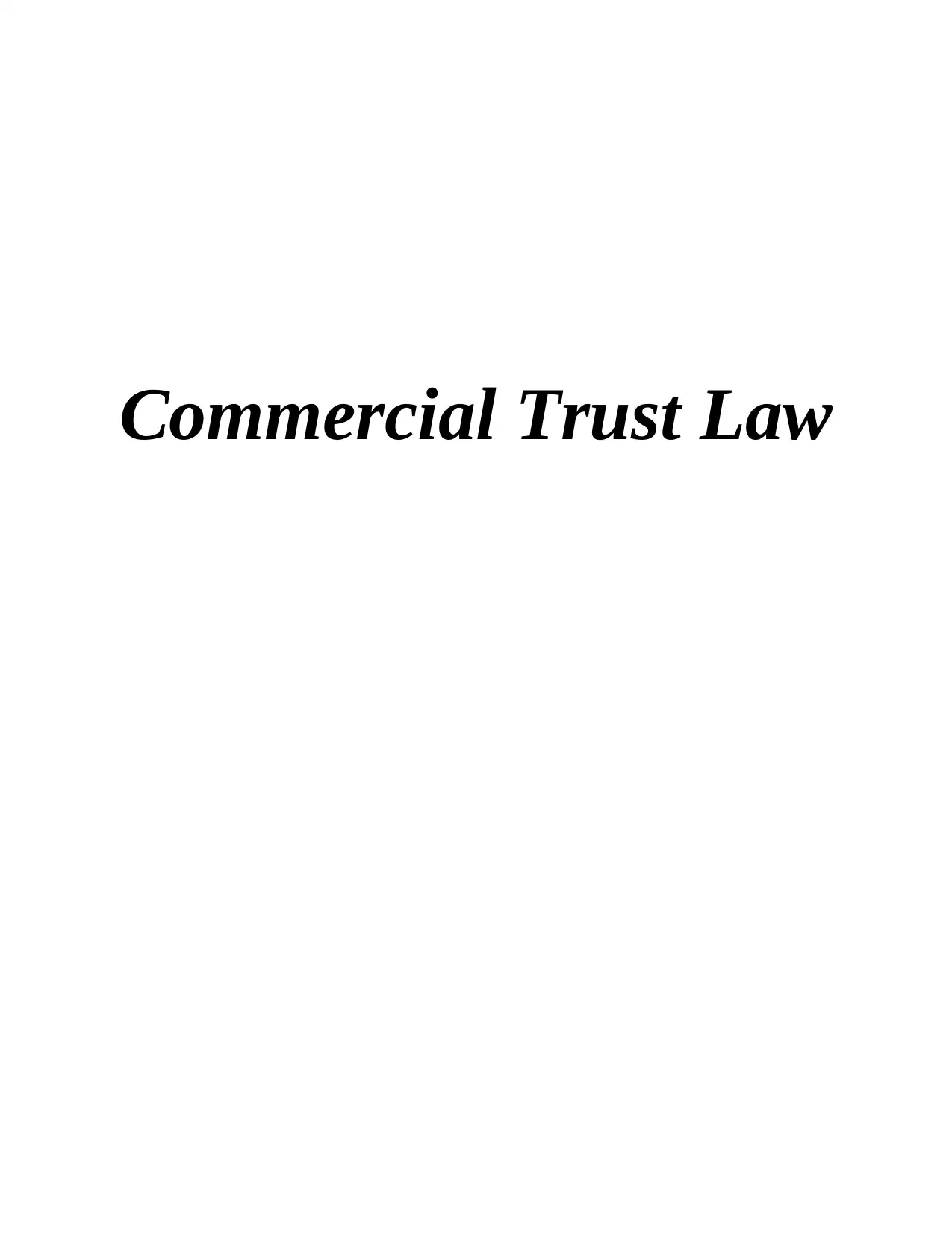
Commercial Trust Law
Paraphrase This Document
Need a fresh take? Get an instant paraphrase of this document with our AI Paraphraser
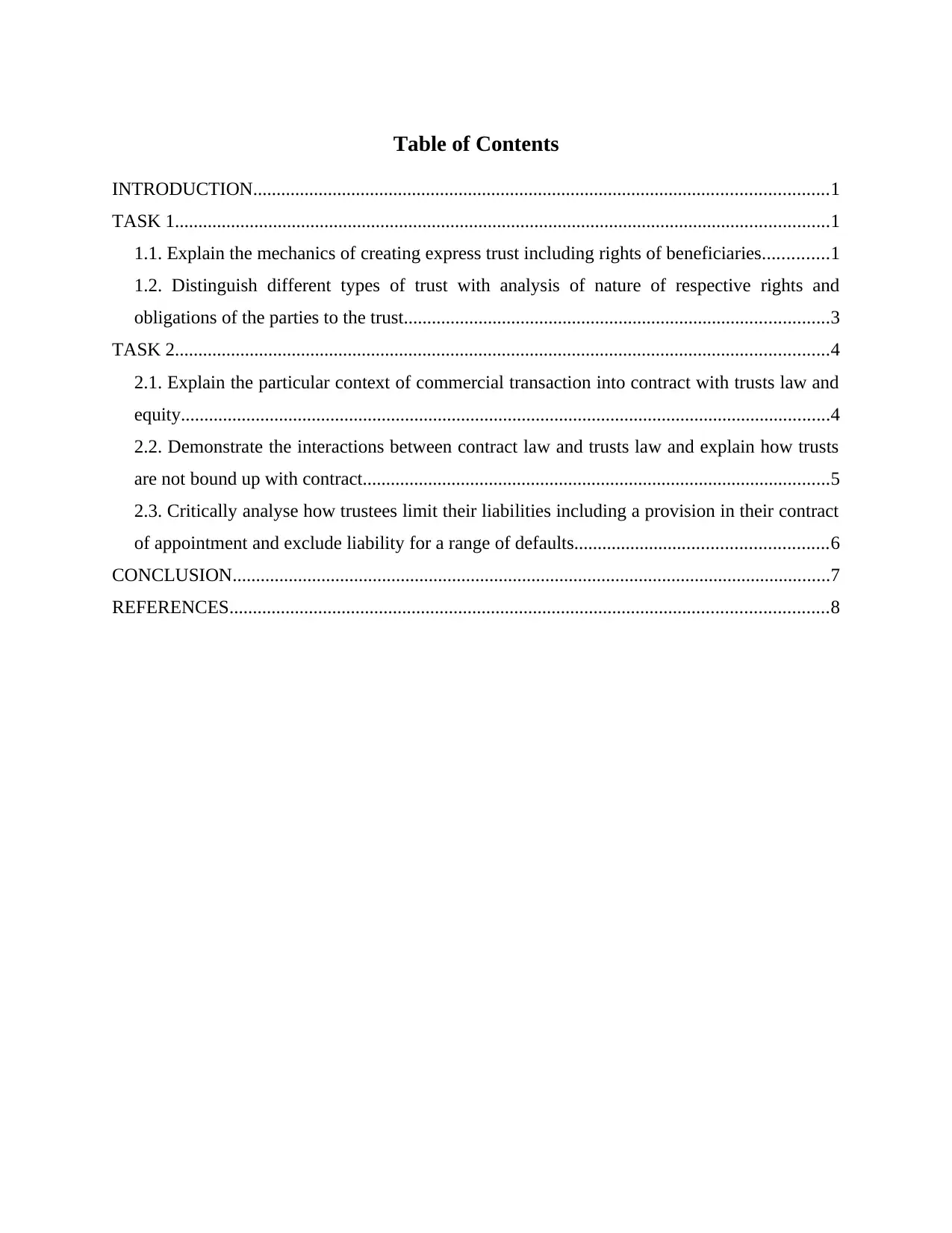
Table of Contents
INTRODUCTION...........................................................................................................................1
TASK 1............................................................................................................................................1
1.1. Explain the mechanics of creating express trust including rights of beneficiaries..............1
1.2. Distinguish different types of trust with analysis of nature of respective rights and
obligations of the parties to the trust...........................................................................................3
TASK 2............................................................................................................................................4
2.1. Explain the particular context of commercial transaction into contract with trusts law and
equity...........................................................................................................................................4
2.2. Demonstrate the interactions between contract law and trusts law and explain how trusts
are not bound up with contract....................................................................................................5
2.3. Critically analyse how trustees limit their liabilities including a provision in their contract
of appointment and exclude liability for a range of defaults......................................................6
CONCLUSION................................................................................................................................7
REFERENCES................................................................................................................................8
INTRODUCTION...........................................................................................................................1
TASK 1............................................................................................................................................1
1.1. Explain the mechanics of creating express trust including rights of beneficiaries..............1
1.2. Distinguish different types of trust with analysis of nature of respective rights and
obligations of the parties to the trust...........................................................................................3
TASK 2............................................................................................................................................4
2.1. Explain the particular context of commercial transaction into contract with trusts law and
equity...........................................................................................................................................4
2.2. Demonstrate the interactions between contract law and trusts law and explain how trusts
are not bound up with contract....................................................................................................5
2.3. Critically analyse how trustees limit their liabilities including a provision in their contract
of appointment and exclude liability for a range of defaults......................................................6
CONCLUSION................................................................................................................................7
REFERENCES................................................................................................................................8
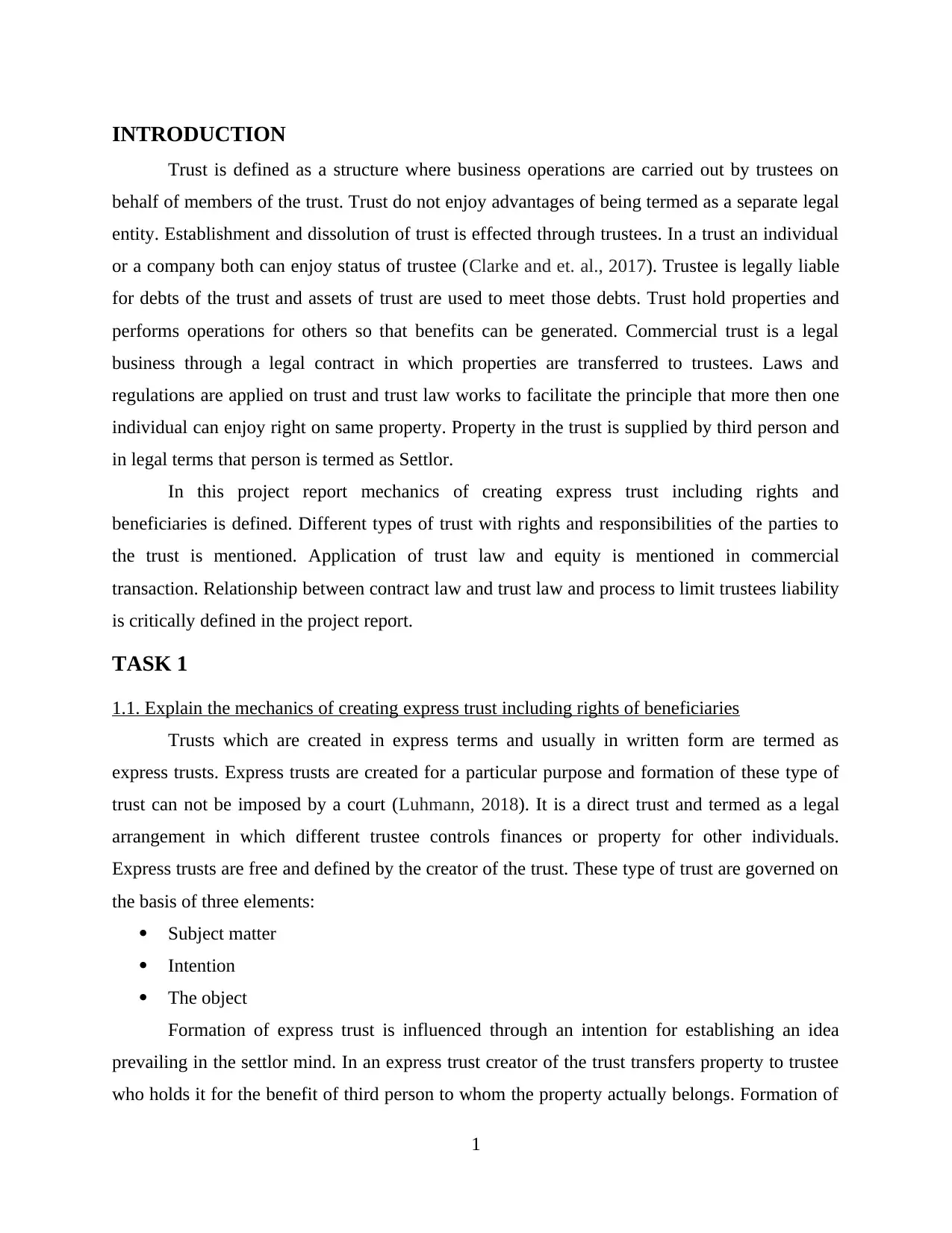
INTRODUCTION
Trust is defined as a structure where business operations are carried out by trustees on
behalf of members of the trust. Trust do not enjoy advantages of being termed as a separate legal
entity. Establishment and dissolution of trust is effected through trustees. In a trust an individual
or a company both can enjoy status of trustee (Clarke and et. al., 2017). Trustee is legally liable
for debts of the trust and assets of trust are used to meet those debts. Trust hold properties and
performs operations for others so that benefits can be generated. Commercial trust is a legal
business through a legal contract in which properties are transferred to trustees. Laws and
regulations are applied on trust and trust law works to facilitate the principle that more then one
individual can enjoy right on same property. Property in the trust is supplied by third person and
in legal terms that person is termed as Settlor.
In this project report mechanics of creating express trust including rights and
beneficiaries is defined. Different types of trust with rights and responsibilities of the parties to
the trust is mentioned. Application of trust law and equity is mentioned in commercial
transaction. Relationship between contract law and trust law and process to limit trustees liability
is critically defined in the project report.
TASK 1
1.1. Explain the mechanics of creating express trust including rights of beneficiaries
Trusts which are created in express terms and usually in written form are termed as
express trusts. Express trusts are created for a particular purpose and formation of these type of
trust can not be imposed by a court (Luhmann, 2018). It is a direct trust and termed as a legal
arrangement in which different trustee controls finances or property for other individuals.
Express trusts are free and defined by the creator of the trust. These type of trust are governed on
the basis of three elements:
Subject matter
Intention
The object
Formation of express trust is influenced through an intention for establishing an idea
prevailing in the settlor mind. In an express trust creator of the trust transfers property to trustee
who holds it for the benefit of third person to whom the property actually belongs. Formation of
1
Trust is defined as a structure where business operations are carried out by trustees on
behalf of members of the trust. Trust do not enjoy advantages of being termed as a separate legal
entity. Establishment and dissolution of trust is effected through trustees. In a trust an individual
or a company both can enjoy status of trustee (Clarke and et. al., 2017). Trustee is legally liable
for debts of the trust and assets of trust are used to meet those debts. Trust hold properties and
performs operations for others so that benefits can be generated. Commercial trust is a legal
business through a legal contract in which properties are transferred to trustees. Laws and
regulations are applied on trust and trust law works to facilitate the principle that more then one
individual can enjoy right on same property. Property in the trust is supplied by third person and
in legal terms that person is termed as Settlor.
In this project report mechanics of creating express trust including rights and
beneficiaries is defined. Different types of trust with rights and responsibilities of the parties to
the trust is mentioned. Application of trust law and equity is mentioned in commercial
transaction. Relationship between contract law and trust law and process to limit trustees liability
is critically defined in the project report.
TASK 1
1.1. Explain the mechanics of creating express trust including rights of beneficiaries
Trusts which are created in express terms and usually in written form are termed as
express trusts. Express trusts are created for a particular purpose and formation of these type of
trust can not be imposed by a court (Luhmann, 2018). It is a direct trust and termed as a legal
arrangement in which different trustee controls finances or property for other individuals.
Express trusts are free and defined by the creator of the trust. These type of trust are governed on
the basis of three elements:
Subject matter
Intention
The object
Formation of express trust is influenced through an intention for establishing an idea
prevailing in the settlor mind. In an express trust creator of the trust transfers property to trustee
who holds it for the benefit of third person to whom the property actually belongs. Formation of
1
⊘ This is a preview!⊘
Do you want full access?
Subscribe today to unlock all pages.

Trusted by 1+ million students worldwide
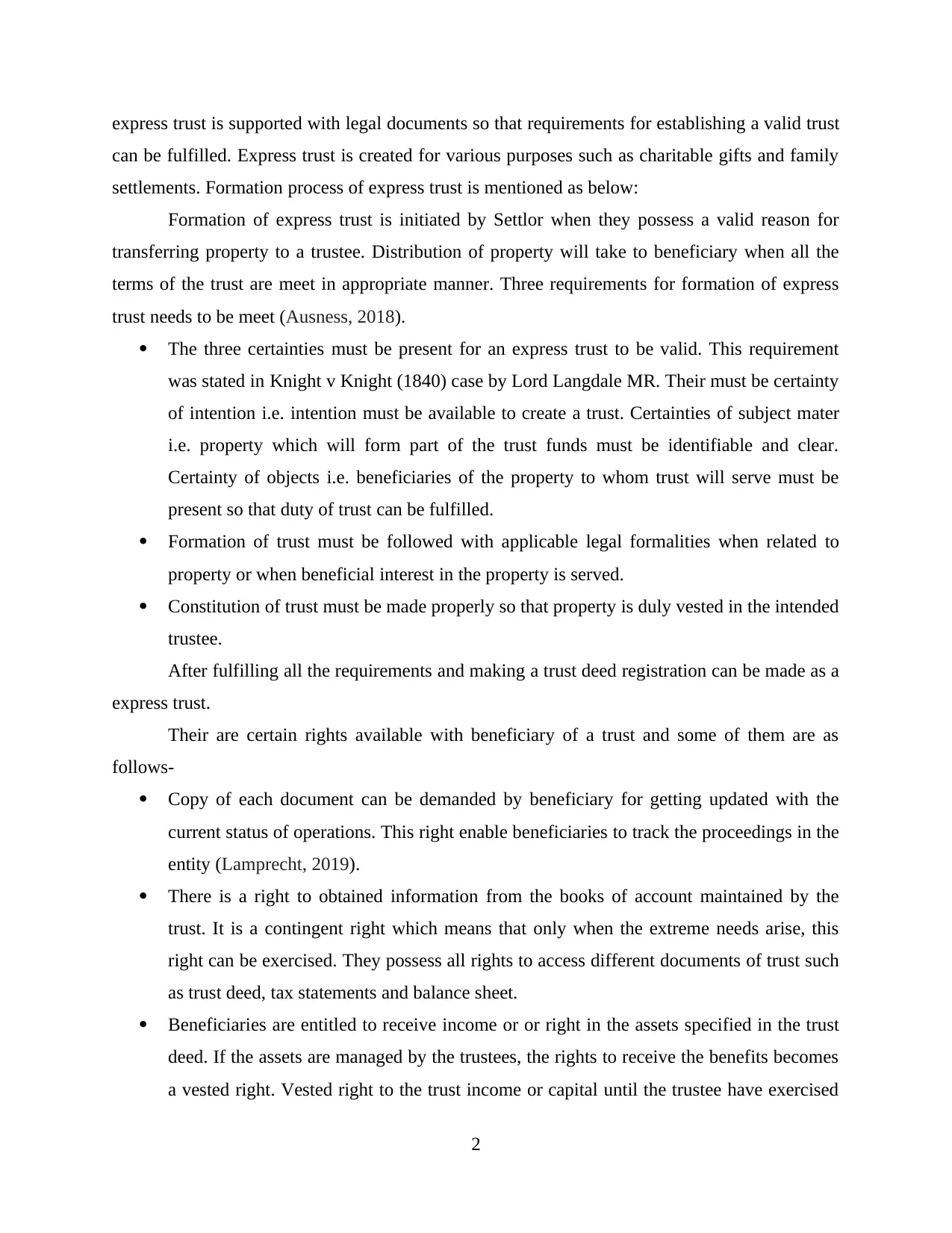
express trust is supported with legal documents so that requirements for establishing a valid trust
can be fulfilled. Express trust is created for various purposes such as charitable gifts and family
settlements. Formation process of express trust is mentioned as below:
Formation of express trust is initiated by Settlor when they possess a valid reason for
transferring property to a trustee. Distribution of property will take to beneficiary when all the
terms of the trust are meet in appropriate manner. Three requirements for formation of express
trust needs to be meet (Ausness, 2018).
The three certainties must be present for an express trust to be valid. This requirement
was stated in Knight v Knight (1840) case by Lord Langdale MR. Their must be certainty
of intention i.e. intention must be available to create a trust. Certainties of subject mater
i.e. property which will form part of the trust funds must be identifiable and clear.
Certainty of objects i.e. beneficiaries of the property to whom trust will serve must be
present so that duty of trust can be fulfilled.
Formation of trust must be followed with applicable legal formalities when related to
property or when beneficial interest in the property is served.
Constitution of trust must be made properly so that property is duly vested in the intended
trustee.
After fulfilling all the requirements and making a trust deed registration can be made as a
express trust.
Their are certain rights available with beneficiary of a trust and some of them are as
follows-
Copy of each document can be demanded by beneficiary for getting updated with the
current status of operations. This right enable beneficiaries to track the proceedings in the
entity (Lamprecht, 2019).
There is a right to obtained information from the books of account maintained by the
trust. It is a contingent right which means that only when the extreme needs arise, this
right can be exercised. They possess all rights to access different documents of trust such
as trust deed, tax statements and balance sheet.
Beneficiaries are entitled to receive income or or right in the assets specified in the trust
deed. If the assets are managed by the trustees, the rights to receive the benefits becomes
a vested right. Vested right to the trust income or capital until the trustee have exercised
2
can be fulfilled. Express trust is created for various purposes such as charitable gifts and family
settlements. Formation process of express trust is mentioned as below:
Formation of express trust is initiated by Settlor when they possess a valid reason for
transferring property to a trustee. Distribution of property will take to beneficiary when all the
terms of the trust are meet in appropriate manner. Three requirements for formation of express
trust needs to be meet (Ausness, 2018).
The three certainties must be present for an express trust to be valid. This requirement
was stated in Knight v Knight (1840) case by Lord Langdale MR. Their must be certainty
of intention i.e. intention must be available to create a trust. Certainties of subject mater
i.e. property which will form part of the trust funds must be identifiable and clear.
Certainty of objects i.e. beneficiaries of the property to whom trust will serve must be
present so that duty of trust can be fulfilled.
Formation of trust must be followed with applicable legal formalities when related to
property or when beneficial interest in the property is served.
Constitution of trust must be made properly so that property is duly vested in the intended
trustee.
After fulfilling all the requirements and making a trust deed registration can be made as a
express trust.
Their are certain rights available with beneficiary of a trust and some of them are as
follows-
Copy of each document can be demanded by beneficiary for getting updated with the
current status of operations. This right enable beneficiaries to track the proceedings in the
entity (Lamprecht, 2019).
There is a right to obtained information from the books of account maintained by the
trust. It is a contingent right which means that only when the extreme needs arise, this
right can be exercised. They possess all rights to access different documents of trust such
as trust deed, tax statements and balance sheet.
Beneficiaries are entitled to receive income or or right in the assets specified in the trust
deed. If the assets are managed by the trustees, the rights to receive the benefits becomes
a vested right. Vested right to the trust income or capital until the trustee have exercised
2
Paraphrase This Document
Need a fresh take? Get an instant paraphrase of this document with our AI Paraphraser
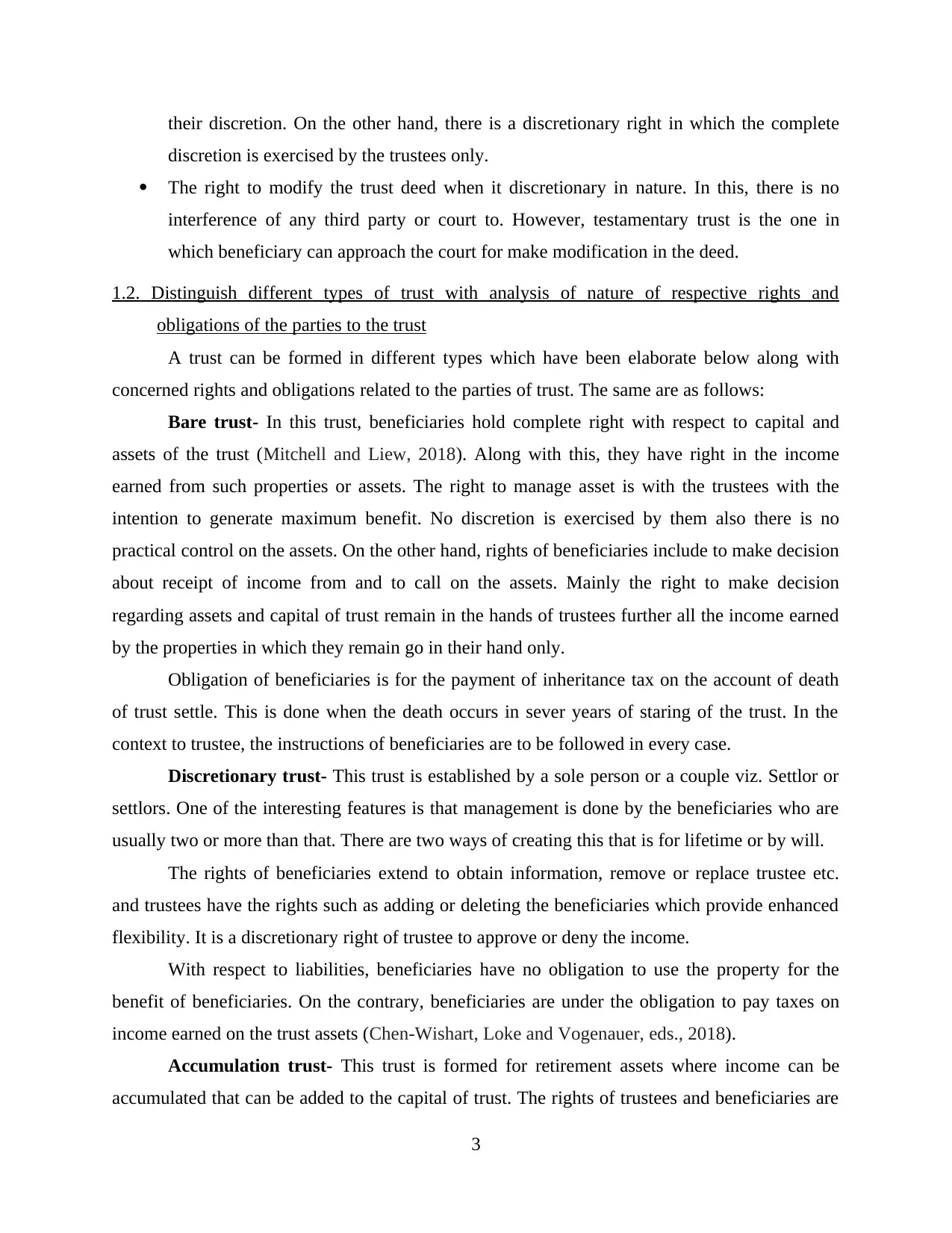
their discretion. On the other hand, there is a discretionary right in which the complete
discretion is exercised by the trustees only.
The right to modify the trust deed when it discretionary in nature. In this, there is no
interference of any third party or court to. However, testamentary trust is the one in
which beneficiary can approach the court for make modification in the deed.
1.2. Distinguish different types of trust with analysis of nature of respective rights and
obligations of the parties to the trust
A trust can be formed in different types which have been elaborate below along with
concerned rights and obligations related to the parties of trust. The same are as follows:
Bare trust- In this trust, beneficiaries hold complete right with respect to capital and
assets of the trust (Mitchell and Liew, 2018). Along with this, they have right in the income
earned from such properties or assets. The right to manage asset is with the trustees with the
intention to generate maximum benefit. No discretion is exercised by them also there is no
practical control on the assets. On the other hand, rights of beneficiaries include to make decision
about receipt of income from and to call on the assets. Mainly the right to make decision
regarding assets and capital of trust remain in the hands of trustees further all the income earned
by the properties in which they remain go in their hand only.
Obligation of beneficiaries is for the payment of inheritance tax on the account of death
of trust settle. This is done when the death occurs in sever years of staring of the trust. In the
context to trustee, the instructions of beneficiaries are to be followed in every case.
Discretionary trust- This trust is established by a sole person or a couple viz. Settlor or
settlors. One of the interesting features is that management is done by the beneficiaries who are
usually two or more than that. There are two ways of creating this that is for lifetime or by will.
The rights of beneficiaries extend to obtain information, remove or replace trustee etc.
and trustees have the rights such as adding or deleting the beneficiaries which provide enhanced
flexibility. It is a discretionary right of trustee to approve or deny the income.
With respect to liabilities, beneficiaries have no obligation to use the property for the
benefit of beneficiaries. On the contrary, beneficiaries are under the obligation to pay taxes on
income earned on the trust assets (Chen-Wishart, Loke and Vogenauer, eds., 2018).
Accumulation trust- This trust is formed for retirement assets where income can be
accumulated that can be added to the capital of trust. The rights of trustees and beneficiaries are
3
discretion is exercised by the trustees only.
The right to modify the trust deed when it discretionary in nature. In this, there is no
interference of any third party or court to. However, testamentary trust is the one in
which beneficiary can approach the court for make modification in the deed.
1.2. Distinguish different types of trust with analysis of nature of respective rights and
obligations of the parties to the trust
A trust can be formed in different types which have been elaborate below along with
concerned rights and obligations related to the parties of trust. The same are as follows:
Bare trust- In this trust, beneficiaries hold complete right with respect to capital and
assets of the trust (Mitchell and Liew, 2018). Along with this, they have right in the income
earned from such properties or assets. The right to manage asset is with the trustees with the
intention to generate maximum benefit. No discretion is exercised by them also there is no
practical control on the assets. On the other hand, rights of beneficiaries include to make decision
about receipt of income from and to call on the assets. Mainly the right to make decision
regarding assets and capital of trust remain in the hands of trustees further all the income earned
by the properties in which they remain go in their hand only.
Obligation of beneficiaries is for the payment of inheritance tax on the account of death
of trust settle. This is done when the death occurs in sever years of staring of the trust. In the
context to trustee, the instructions of beneficiaries are to be followed in every case.
Discretionary trust- This trust is established by a sole person or a couple viz. Settlor or
settlors. One of the interesting features is that management is done by the beneficiaries who are
usually two or more than that. There are two ways of creating this that is for lifetime or by will.
The rights of beneficiaries extend to obtain information, remove or replace trustee etc.
and trustees have the rights such as adding or deleting the beneficiaries which provide enhanced
flexibility. It is a discretionary right of trustee to approve or deny the income.
With respect to liabilities, beneficiaries have no obligation to use the property for the
benefit of beneficiaries. On the contrary, beneficiaries are under the obligation to pay taxes on
income earned on the trust assets (Chen-Wishart, Loke and Vogenauer, eds., 2018).
Accumulation trust- This trust is formed for retirement assets where income can be
accumulated that can be added to the capital of trust. The rights of trustees and beneficiaries are
3
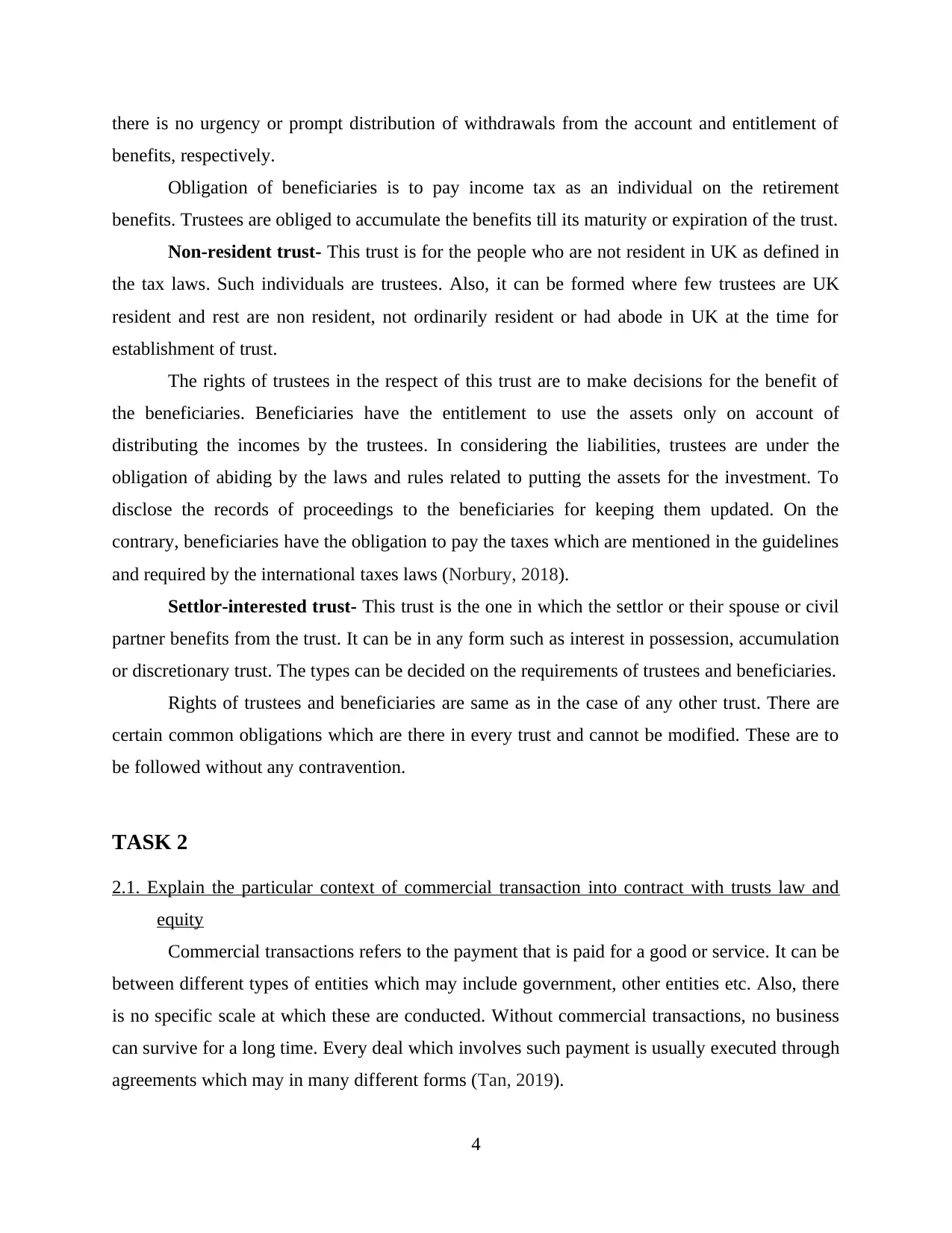
there is no urgency or prompt distribution of withdrawals from the account and entitlement of
benefits, respectively.
Obligation of beneficiaries is to pay income tax as an individual on the retirement
benefits. Trustees are obliged to accumulate the benefits till its maturity or expiration of the trust.
Non-resident trust- This trust is for the people who are not resident in UK as defined in
the tax laws. Such individuals are trustees. Also, it can be formed where few trustees are UK
resident and rest are non resident, not ordinarily resident or had abode in UK at the time for
establishment of trust.
The rights of trustees in the respect of this trust are to make decisions for the benefit of
the beneficiaries. Beneficiaries have the entitlement to use the assets only on account of
distributing the incomes by the trustees. In considering the liabilities, trustees are under the
obligation of abiding by the laws and rules related to putting the assets for the investment. To
disclose the records of proceedings to the beneficiaries for keeping them updated. On the
contrary, beneficiaries have the obligation to pay the taxes which are mentioned in the guidelines
and required by the international taxes laws (Norbury, 2018).
Settlor-interested trust- This trust is the one in which the settlor or their spouse or civil
partner benefits from the trust. It can be in any form such as interest in possession, accumulation
or discretionary trust. The types can be decided on the requirements of trustees and beneficiaries.
Rights of trustees and beneficiaries are same as in the case of any other trust. There are
certain common obligations which are there in every trust and cannot be modified. These are to
be followed without any contravention.
TASK 2
2.1. Explain the particular context of commercial transaction into contract with trusts law and
equity
Commercial transactions refers to the payment that is paid for a good or service. It can be
between different types of entities which may include government, other entities etc. Also, there
is no specific scale at which these are conducted. Without commercial transactions, no business
can survive for a long time. Every deal which involves such payment is usually executed through
agreements which may in many different forms (Tan, 2019).
4
benefits, respectively.
Obligation of beneficiaries is to pay income tax as an individual on the retirement
benefits. Trustees are obliged to accumulate the benefits till its maturity or expiration of the trust.
Non-resident trust- This trust is for the people who are not resident in UK as defined in
the tax laws. Such individuals are trustees. Also, it can be formed where few trustees are UK
resident and rest are non resident, not ordinarily resident or had abode in UK at the time for
establishment of trust.
The rights of trustees in the respect of this trust are to make decisions for the benefit of
the beneficiaries. Beneficiaries have the entitlement to use the assets only on account of
distributing the incomes by the trustees. In considering the liabilities, trustees are under the
obligation of abiding by the laws and rules related to putting the assets for the investment. To
disclose the records of proceedings to the beneficiaries for keeping them updated. On the
contrary, beneficiaries have the obligation to pay the taxes which are mentioned in the guidelines
and required by the international taxes laws (Norbury, 2018).
Settlor-interested trust- This trust is the one in which the settlor or their spouse or civil
partner benefits from the trust. It can be in any form such as interest in possession, accumulation
or discretionary trust. The types can be decided on the requirements of trustees and beneficiaries.
Rights of trustees and beneficiaries are same as in the case of any other trust. There are
certain common obligations which are there in every trust and cannot be modified. These are to
be followed without any contravention.
TASK 2
2.1. Explain the particular context of commercial transaction into contract with trusts law and
equity
Commercial transactions refers to the payment that is paid for a good or service. It can be
between different types of entities which may include government, other entities etc. Also, there
is no specific scale at which these are conducted. Without commercial transactions, no business
can survive for a long time. Every deal which involves such payment is usually executed through
agreements which may in many different forms (Tan, 2019).
4
⊘ This is a preview!⊘
Do you want full access?
Subscribe today to unlock all pages.

Trusted by 1+ million students worldwide
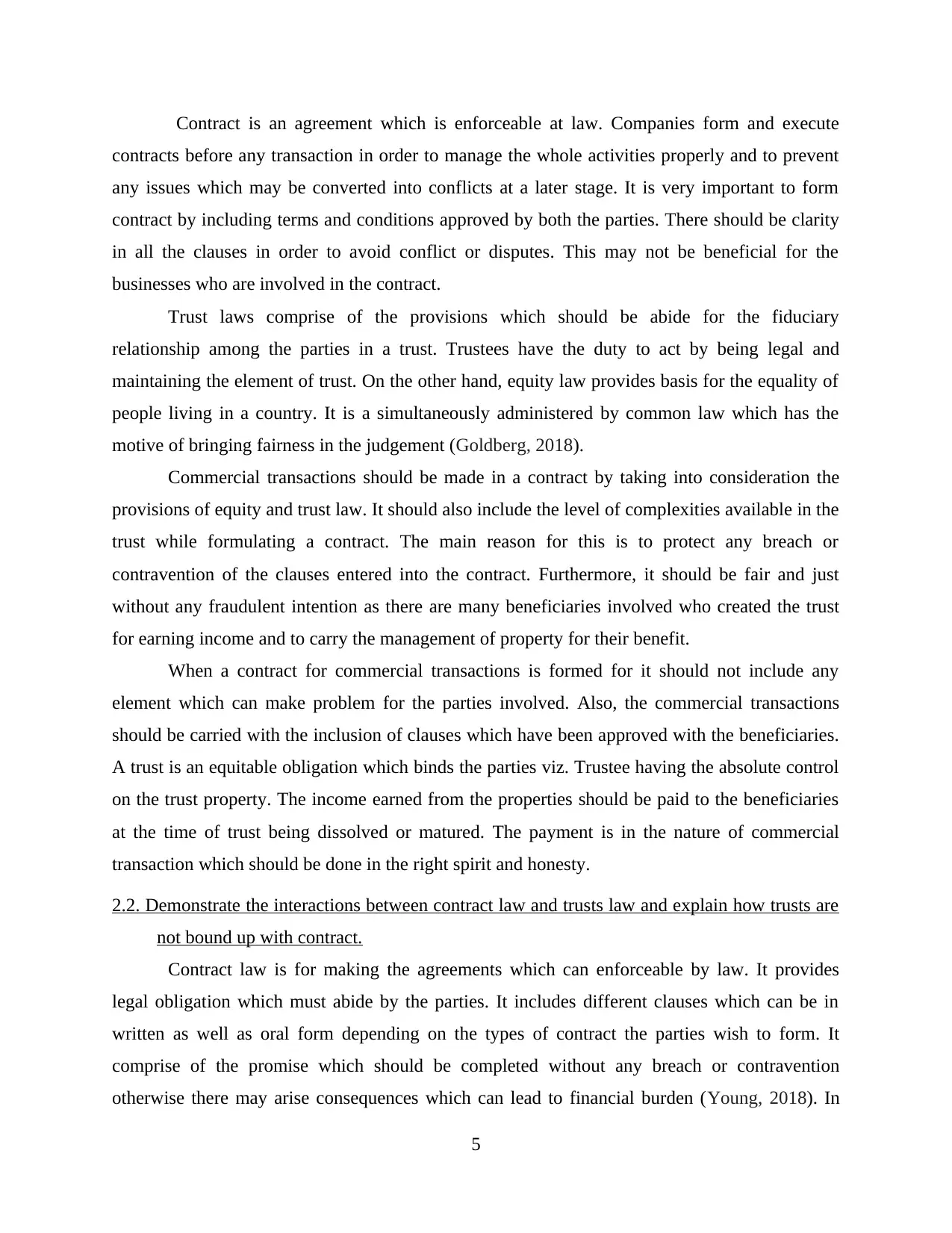
Contract is an agreement which is enforceable at law. Companies form and execute
contracts before any transaction in order to manage the whole activities properly and to prevent
any issues which may be converted into conflicts at a later stage. It is very important to form
contract by including terms and conditions approved by both the parties. There should be clarity
in all the clauses in order to avoid conflict or disputes. This may not be beneficial for the
businesses who are involved in the contract.
Trust laws comprise of the provisions which should be abide for the fiduciary
relationship among the parties in a trust. Trustees have the duty to act by being legal and
maintaining the element of trust. On the other hand, equity law provides basis for the equality of
people living in a country. It is a simultaneously administered by common law which has the
motive of bringing fairness in the judgement (Goldberg, 2018).
Commercial transactions should be made in a contract by taking into consideration the
provisions of equity and trust law. It should also include the level of complexities available in the
trust while formulating a contract. The main reason for this is to protect any breach or
contravention of the clauses entered into the contract. Furthermore, it should be fair and just
without any fraudulent intention as there are many beneficiaries involved who created the trust
for earning income and to carry the management of property for their benefit.
When a contract for commercial transactions is formed for it should not include any
element which can make problem for the parties involved. Also, the commercial transactions
should be carried with the inclusion of clauses which have been approved with the beneficiaries.
A trust is an equitable obligation which binds the parties viz. Trustee having the absolute control
on the trust property. The income earned from the properties should be paid to the beneficiaries
at the time of trust being dissolved or matured. The payment is in the nature of commercial
transaction which should be done in the right spirit and honesty.
2.2. Demonstrate the interactions between contract law and trusts law and explain how trusts are
not bound up with contract.
Contract law is for making the agreements which can enforceable by law. It provides
legal obligation which must abide by the parties. It includes different clauses which can be in
written as well as oral form depending on the types of contract the parties wish to form. It
comprise of the promise which should be completed without any breach or contravention
otherwise there may arise consequences which can lead to financial burden (Young, 2018). In
5
contracts before any transaction in order to manage the whole activities properly and to prevent
any issues which may be converted into conflicts at a later stage. It is very important to form
contract by including terms and conditions approved by both the parties. There should be clarity
in all the clauses in order to avoid conflict or disputes. This may not be beneficial for the
businesses who are involved in the contract.
Trust laws comprise of the provisions which should be abide for the fiduciary
relationship among the parties in a trust. Trustees have the duty to act by being legal and
maintaining the element of trust. On the other hand, equity law provides basis for the equality of
people living in a country. It is a simultaneously administered by common law which has the
motive of bringing fairness in the judgement (Goldberg, 2018).
Commercial transactions should be made in a contract by taking into consideration the
provisions of equity and trust law. It should also include the level of complexities available in the
trust while formulating a contract. The main reason for this is to protect any breach or
contravention of the clauses entered into the contract. Furthermore, it should be fair and just
without any fraudulent intention as there are many beneficiaries involved who created the trust
for earning income and to carry the management of property for their benefit.
When a contract for commercial transactions is formed for it should not include any
element which can make problem for the parties involved. Also, the commercial transactions
should be carried with the inclusion of clauses which have been approved with the beneficiaries.
A trust is an equitable obligation which binds the parties viz. Trustee having the absolute control
on the trust property. The income earned from the properties should be paid to the beneficiaries
at the time of trust being dissolved or matured. The payment is in the nature of commercial
transaction which should be done in the right spirit and honesty.
2.2. Demonstrate the interactions between contract law and trusts law and explain how trusts are
not bound up with contract.
Contract law is for making the agreements which can enforceable by law. It provides
legal obligation which must abide by the parties. It includes different clauses which can be in
written as well as oral form depending on the types of contract the parties wish to form. It
comprise of the promise which should be completed without any breach or contravention
otherwise there may arise consequences which can lead to financial burden (Young, 2018). In
5
Paraphrase This Document
Need a fresh take? Get an instant paraphrase of this document with our AI Paraphraser
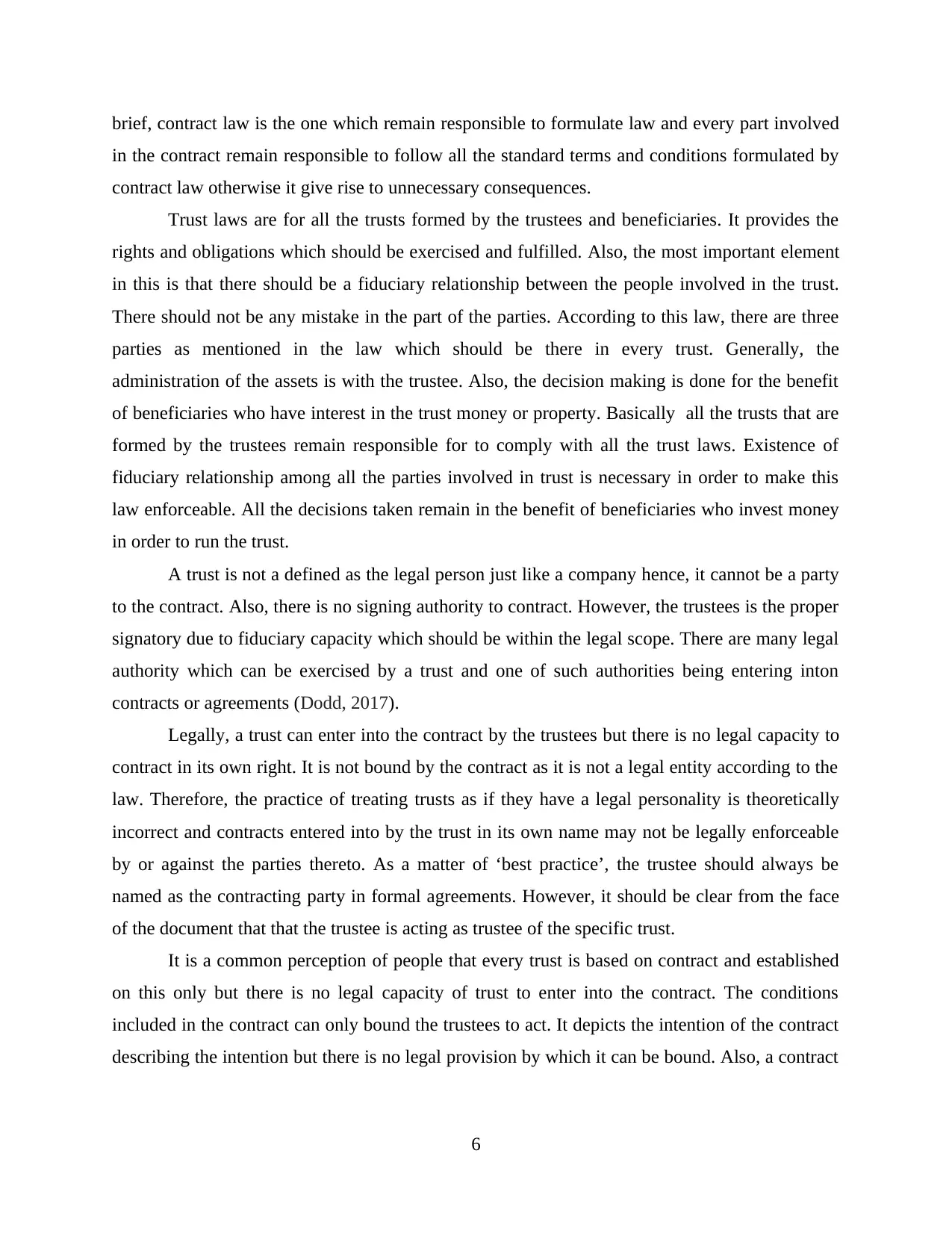
brief, contract law is the one which remain responsible to formulate law and every part involved
in the contract remain responsible to follow all the standard terms and conditions formulated by
contract law otherwise it give rise to unnecessary consequences.
Trust laws are for all the trusts formed by the trustees and beneficiaries. It provides the
rights and obligations which should be exercised and fulfilled. Also, the most important element
in this is that there should be a fiduciary relationship between the people involved in the trust.
There should not be any mistake in the part of the parties. According to this law, there are three
parties as mentioned in the law which should be there in every trust. Generally, the
administration of the assets is with the trustee. Also, the decision making is done for the benefit
of beneficiaries who have interest in the trust money or property. Basically all the trusts that are
formed by the trustees remain responsible for to comply with all the trust laws. Existence of
fiduciary relationship among all the parties involved in trust is necessary in order to make this
law enforceable. All the decisions taken remain in the benefit of beneficiaries who invest money
in order to run the trust.
A trust is not a defined as the legal person just like a company hence, it cannot be a party
to the contract. Also, there is no signing authority to contract. However, the trustees is the proper
signatory due to fiduciary capacity which should be within the legal scope. There are many legal
authority which can be exercised by a trust and one of such authorities being entering inton
contracts or agreements (Dodd, 2017).
Legally, a trust can enter into the contract by the trustees but there is no legal capacity to
contract in its own right. It is not bound by the contract as it is not a legal entity according to the
law. Therefore, the practice of treating trusts as if they have a legal personality is theoretically
incorrect and contracts entered into by the trust in its own name may not be legally enforceable
by or against the parties thereto. As a matter of ‘best practice’, the trustee should always be
named as the contracting party in formal agreements. However, it should be clear from the face
of the document that that the trustee is acting as trustee of the specific trust.
It is a common perception of people that every trust is based on contract and established
on this only but there is no legal capacity of trust to enter into the contract. The conditions
included in the contract can only bound the trustees to act. It depicts the intention of the contract
describing the intention but there is no legal provision by which it can be bound. Also, a contract
6
in the contract remain responsible to follow all the standard terms and conditions formulated by
contract law otherwise it give rise to unnecessary consequences.
Trust laws are for all the trusts formed by the trustees and beneficiaries. It provides the
rights and obligations which should be exercised and fulfilled. Also, the most important element
in this is that there should be a fiduciary relationship between the people involved in the trust.
There should not be any mistake in the part of the parties. According to this law, there are three
parties as mentioned in the law which should be there in every trust. Generally, the
administration of the assets is with the trustee. Also, the decision making is done for the benefit
of beneficiaries who have interest in the trust money or property. Basically all the trusts that are
formed by the trustees remain responsible for to comply with all the trust laws. Existence of
fiduciary relationship among all the parties involved in trust is necessary in order to make this
law enforceable. All the decisions taken remain in the benefit of beneficiaries who invest money
in order to run the trust.
A trust is not a defined as the legal person just like a company hence, it cannot be a party
to the contract. Also, there is no signing authority to contract. However, the trustees is the proper
signatory due to fiduciary capacity which should be within the legal scope. There are many legal
authority which can be exercised by a trust and one of such authorities being entering inton
contracts or agreements (Dodd, 2017).
Legally, a trust can enter into the contract by the trustees but there is no legal capacity to
contract in its own right. It is not bound by the contract as it is not a legal entity according to the
law. Therefore, the practice of treating trusts as if they have a legal personality is theoretically
incorrect and contracts entered into by the trust in its own name may not be legally enforceable
by or against the parties thereto. As a matter of ‘best practice’, the trustee should always be
named as the contracting party in formal agreements. However, it should be clear from the face
of the document that that the trustee is acting as trustee of the specific trust.
It is a common perception of people that every trust is based on contract and established
on this only but there is no legal capacity of trust to enter into the contract. The conditions
included in the contract can only bound the trustees to act. It depicts the intention of the contract
describing the intention but there is no legal provision by which it can be bound. Also, a contract
6
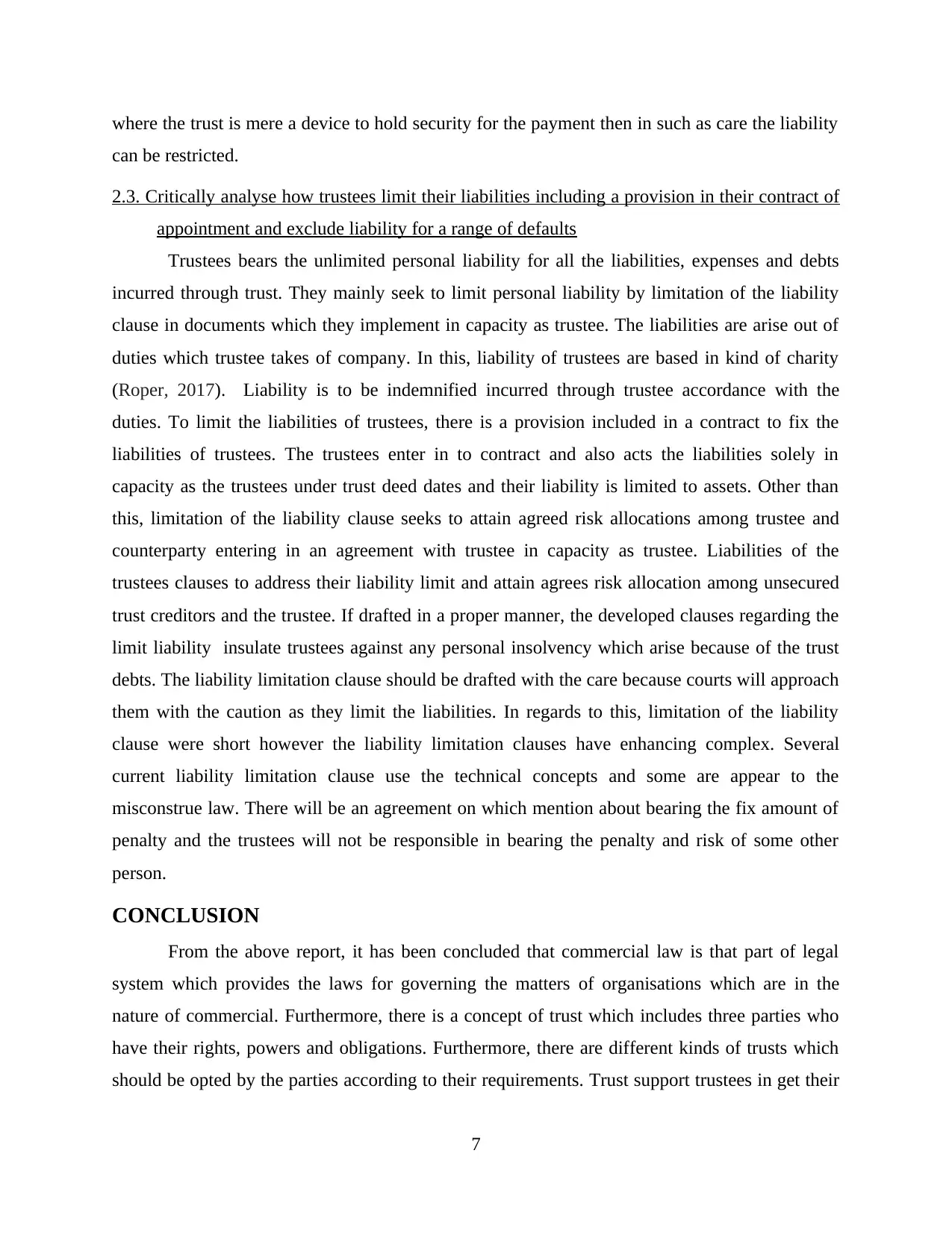
where the trust is mere a device to hold security for the payment then in such as care the liability
can be restricted.
2.3. Critically analyse how trustees limit their liabilities including a provision in their contract of
appointment and exclude liability for a range of defaults
Trustees bears the unlimited personal liability for all the liabilities, expenses and debts
incurred through trust. They mainly seek to limit personal liability by limitation of the liability
clause in documents which they implement in capacity as trustee. The liabilities are arise out of
duties which trustee takes of company. In this, liability of trustees are based in kind of charity
(Roper, 2017). Liability is to be indemnified incurred through trustee accordance with the
duties. To limit the liabilities of trustees, there is a provision included in a contract to fix the
liabilities of trustees. The trustees enter in to contract and also acts the liabilities solely in
capacity as the trustees under trust deed dates and their liability is limited to assets. Other than
this, limitation of the liability clause seeks to attain agreed risk allocations among trustee and
counterparty entering in an agreement with trustee in capacity as trustee. Liabilities of the
trustees clauses to address their liability limit and attain agrees risk allocation among unsecured
trust creditors and the trustee. If drafted in a proper manner, the developed clauses regarding the
limit liability insulate trustees against any personal insolvency which arise because of the trust
debts. The liability limitation clause should be drafted with the care because courts will approach
them with the caution as they limit the liabilities. In regards to this, limitation of the liability
clause were short however the liability limitation clauses have enhancing complex. Several
current liability limitation clause use the technical concepts and some are appear to the
misconstrue law. There will be an agreement on which mention about bearing the fix amount of
penalty and the trustees will not be responsible in bearing the penalty and risk of some other
person.
CONCLUSION
From the above report, it has been concluded that commercial law is that part of legal
system which provides the laws for governing the matters of organisations which are in the
nature of commercial. Furthermore, there is a concept of trust which includes three parties who
have their rights, powers and obligations. Furthermore, there are different kinds of trusts which
should be opted by the parties according to their requirements. Trust support trustees in get their
7
can be restricted.
2.3. Critically analyse how trustees limit their liabilities including a provision in their contract of
appointment and exclude liability for a range of defaults
Trustees bears the unlimited personal liability for all the liabilities, expenses and debts
incurred through trust. They mainly seek to limit personal liability by limitation of the liability
clause in documents which they implement in capacity as trustee. The liabilities are arise out of
duties which trustee takes of company. In this, liability of trustees are based in kind of charity
(Roper, 2017). Liability is to be indemnified incurred through trustee accordance with the
duties. To limit the liabilities of trustees, there is a provision included in a contract to fix the
liabilities of trustees. The trustees enter in to contract and also acts the liabilities solely in
capacity as the trustees under trust deed dates and their liability is limited to assets. Other than
this, limitation of the liability clause seeks to attain agreed risk allocations among trustee and
counterparty entering in an agreement with trustee in capacity as trustee. Liabilities of the
trustees clauses to address their liability limit and attain agrees risk allocation among unsecured
trust creditors and the trustee. If drafted in a proper manner, the developed clauses regarding the
limit liability insulate trustees against any personal insolvency which arise because of the trust
debts. The liability limitation clause should be drafted with the care because courts will approach
them with the caution as they limit the liabilities. In regards to this, limitation of the liability
clause were short however the liability limitation clauses have enhancing complex. Several
current liability limitation clause use the technical concepts and some are appear to the
misconstrue law. There will be an agreement on which mention about bearing the fix amount of
penalty and the trustees will not be responsible in bearing the penalty and risk of some other
person.
CONCLUSION
From the above report, it has been concluded that commercial law is that part of legal
system which provides the laws for governing the matters of organisations which are in the
nature of commercial. Furthermore, there is a concept of trust which includes three parties who
have their rights, powers and obligations. Furthermore, there are different kinds of trusts which
should be opted by the parties according to their requirements. Trust support trustees in get their
7
⊘ This is a preview!⊘
Do you want full access?
Subscribe today to unlock all pages.

Trusted by 1+ million students worldwide
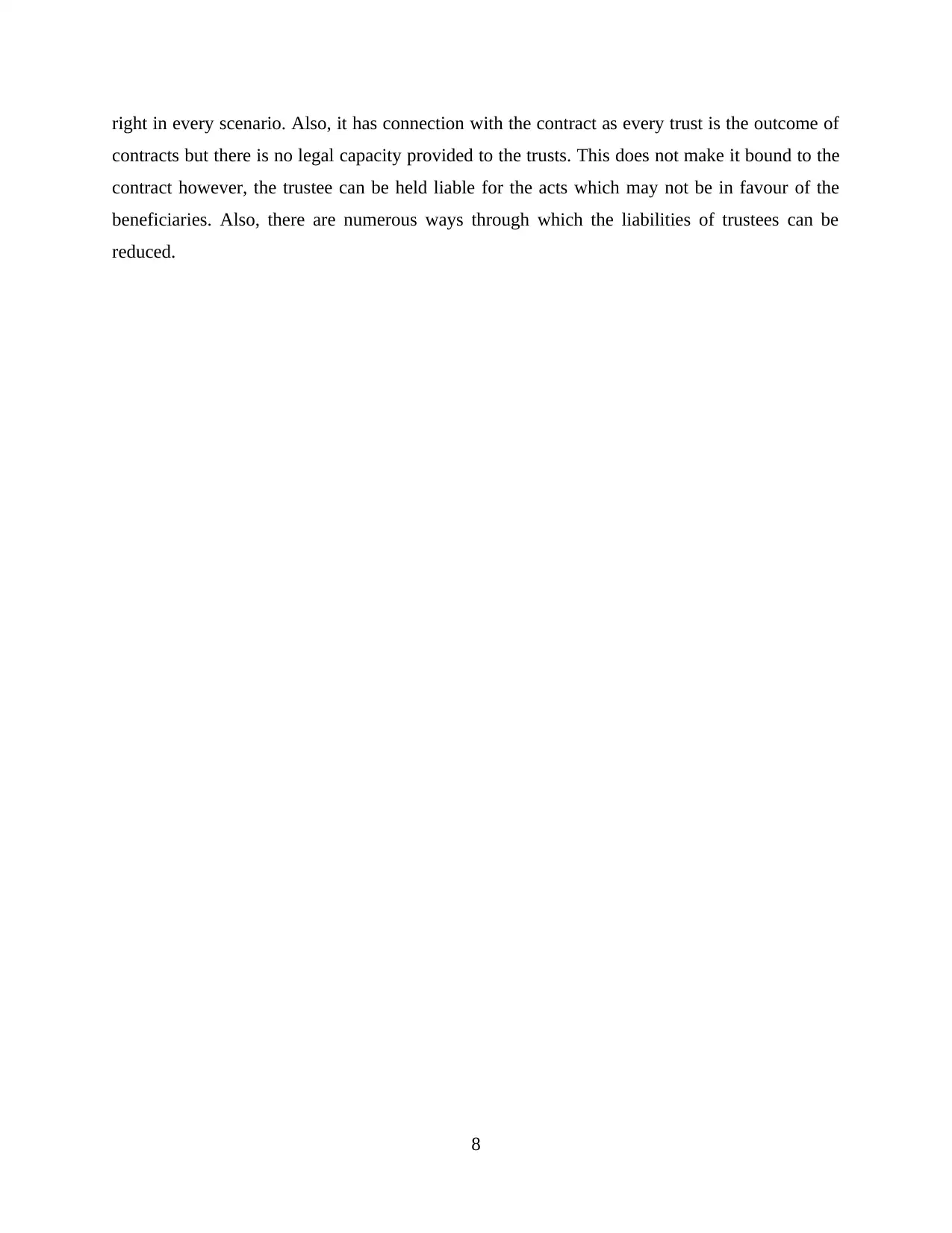
right in every scenario. Also, it has connection with the contract as every trust is the outcome of
contracts but there is no legal capacity provided to the trusts. This does not make it bound to the
contract however, the trustee can be held liable for the acts which may not be in favour of the
beneficiaries. Also, there are numerous ways through which the liabilities of trustees can be
reduced.
8
contracts but there is no legal capacity provided to the trusts. This does not make it bound to the
contract however, the trustee can be held liable for the acts which may not be in favour of the
beneficiaries. Also, there are numerous ways through which the liabilities of trustees can be
reduced.
8
Paraphrase This Document
Need a fresh take? Get an instant paraphrase of this document with our AI Paraphraser
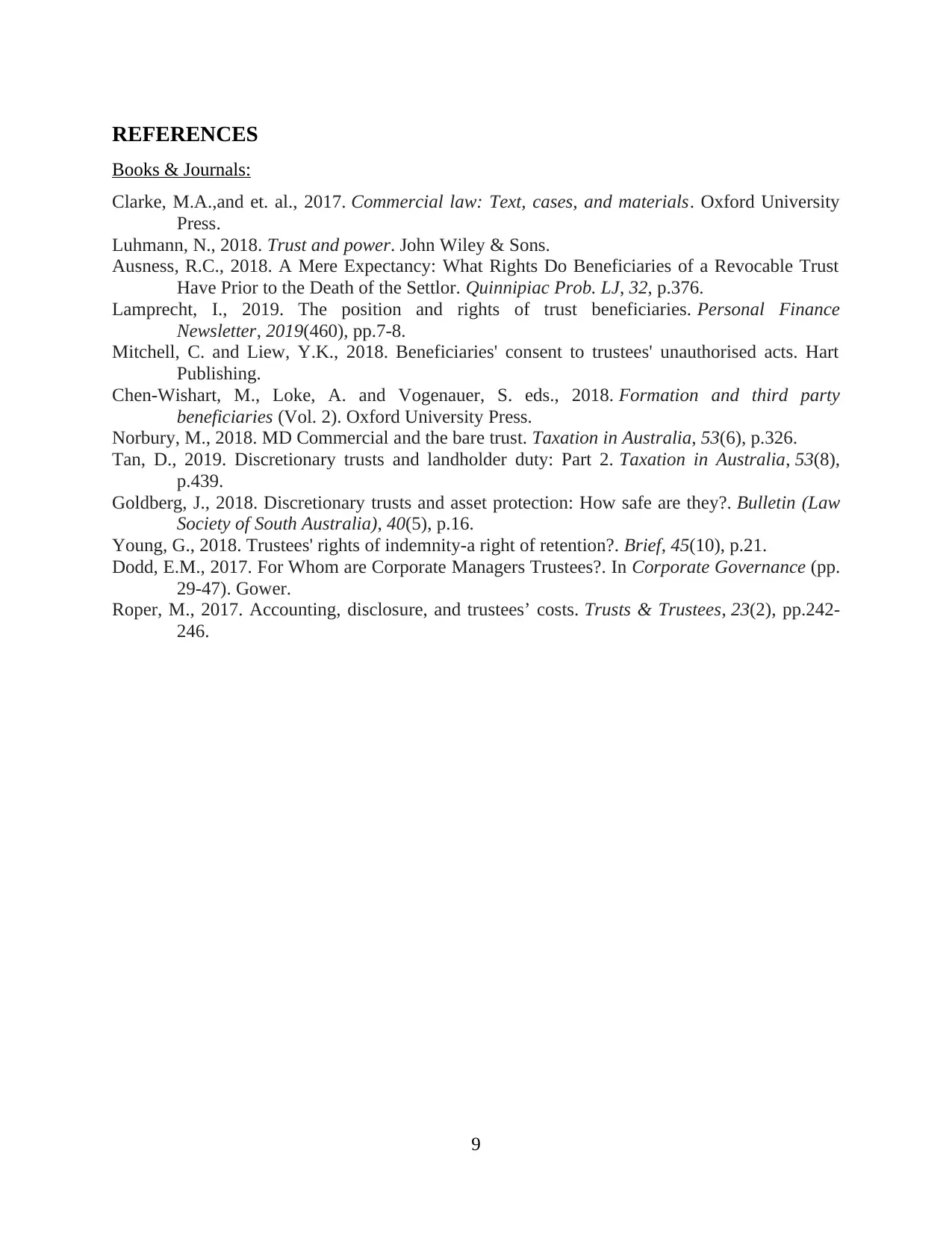
REFERENCES
Books & Journals:
Clarke, M.A.,and et. al., 2017. Commercial law: Text, cases, and materials. Oxford University
Press.
Luhmann, N., 2018. Trust and power. John Wiley & Sons.
Ausness, R.C., 2018. A Mere Expectancy: What Rights Do Beneficiaries of a Revocable Trust
Have Prior to the Death of the Settlor. Quinnipiac Prob. LJ, 32, p.376.
Lamprecht, I., 2019. The position and rights of trust beneficiaries. Personal Finance
Newsletter, 2019(460), pp.7-8.
Mitchell, C. and Liew, Y.K., 2018. Beneficiaries' consent to trustees' unauthorised acts. Hart
Publishing.
Chen-Wishart, M., Loke, A. and Vogenauer, S. eds., 2018. Formation and third party
beneficiaries (Vol. 2). Oxford University Press.
Norbury, M., 2018. MD Commercial and the bare trust. Taxation in Australia, 53(6), p.326.
Tan, D., 2019. Discretionary trusts and landholder duty: Part 2. Taxation in Australia, 53(8),
p.439.
Goldberg, J., 2018. Discretionary trusts and asset protection: How safe are they?. Bulletin (Law
Society of South Australia), 40(5), p.16.
Young, G., 2018. Trustees' rights of indemnity-a right of retention?. Brief, 45(10), p.21.
Dodd, E.M., 2017. For Whom are Corporate Managers Trustees?. In Corporate Governance (pp.
29-47). Gower.
Roper, M., 2017. Accounting, disclosure, and trustees’ costs. Trusts & Trustees, 23(2), pp.242-
246.
9
Books & Journals:
Clarke, M.A.,and et. al., 2017. Commercial law: Text, cases, and materials. Oxford University
Press.
Luhmann, N., 2018. Trust and power. John Wiley & Sons.
Ausness, R.C., 2018. A Mere Expectancy: What Rights Do Beneficiaries of a Revocable Trust
Have Prior to the Death of the Settlor. Quinnipiac Prob. LJ, 32, p.376.
Lamprecht, I., 2019. The position and rights of trust beneficiaries. Personal Finance
Newsletter, 2019(460), pp.7-8.
Mitchell, C. and Liew, Y.K., 2018. Beneficiaries' consent to trustees' unauthorised acts. Hart
Publishing.
Chen-Wishart, M., Loke, A. and Vogenauer, S. eds., 2018. Formation and third party
beneficiaries (Vol. 2). Oxford University Press.
Norbury, M., 2018. MD Commercial and the bare trust. Taxation in Australia, 53(6), p.326.
Tan, D., 2019. Discretionary trusts and landholder duty: Part 2. Taxation in Australia, 53(8),
p.439.
Goldberg, J., 2018. Discretionary trusts and asset protection: How safe are they?. Bulletin (Law
Society of South Australia), 40(5), p.16.
Young, G., 2018. Trustees' rights of indemnity-a right of retention?. Brief, 45(10), p.21.
Dodd, E.M., 2017. For Whom are Corporate Managers Trustees?. In Corporate Governance (pp.
29-47). Gower.
Roper, M., 2017. Accounting, disclosure, and trustees’ costs. Trusts & Trustees, 23(2), pp.242-
246.
9
1 out of 11
Related Documents
Your All-in-One AI-Powered Toolkit for Academic Success.
+13062052269
info@desklib.com
Available 24*7 on WhatsApp / Email
![[object Object]](/_next/static/media/star-bottom.7253800d.svg)
Unlock your academic potential
Copyright © 2020–2025 A2Z Services. All Rights Reserved. Developed and managed by ZUCOL.





